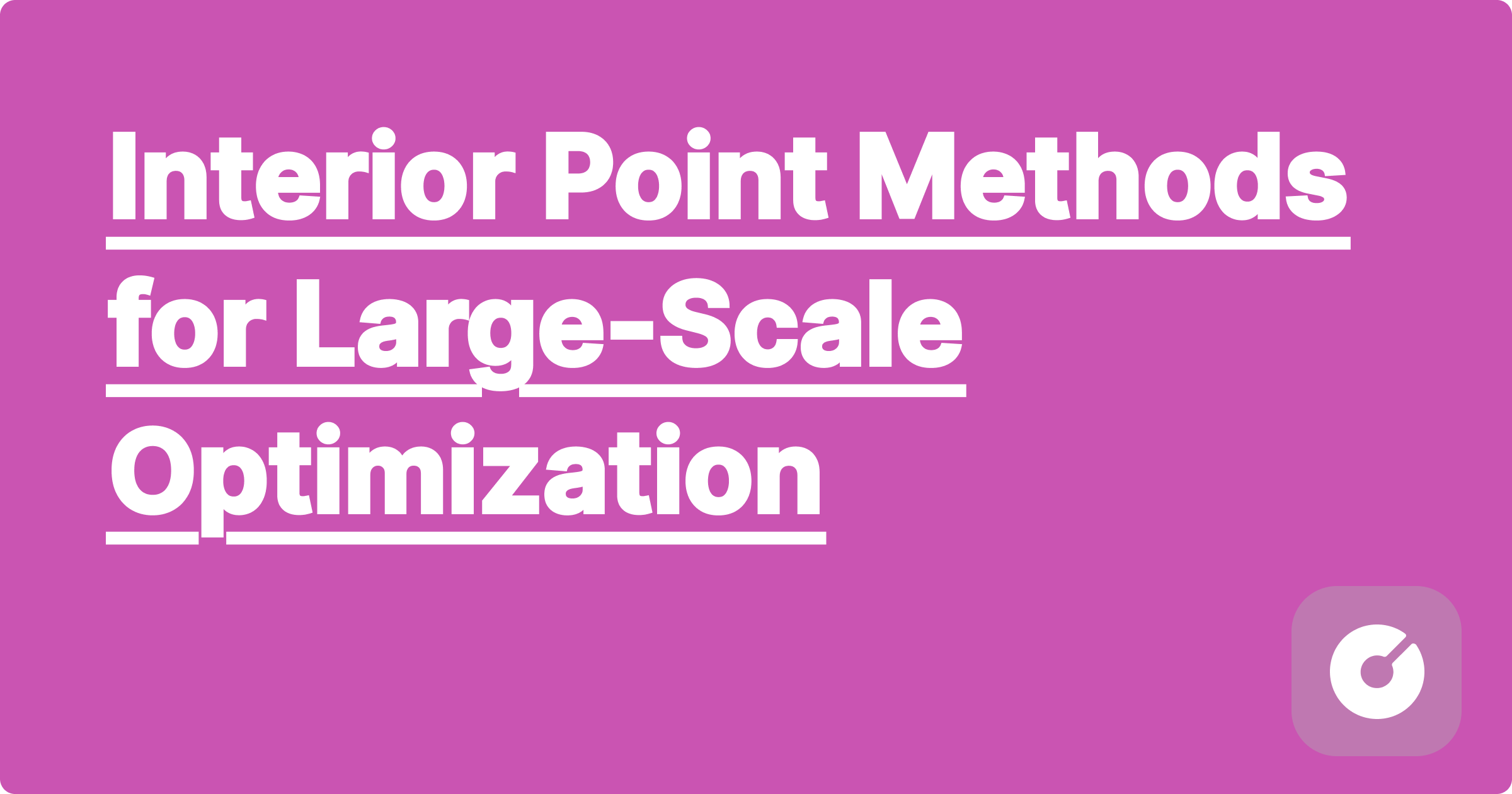
Interior Point Methods for Large-Scale Optimization
pre {
background-color: #f4f4f4;
padding: 10px;
border-radius: 5px;
overflow-x: auto;
}
.equation {
background-color: #f0f0f0;
padding: 10px;
border-radius: 5px;
font-family: "Times New Roman", serif;
}
.tip {
background-color: #e0ffe0;
padding: 10px;
border-radius: 5px;
}
.warning {
background-color: #fff2e0;
padding: 10px;
border-radius: 5px;
}
This blog post provides a comprehensive overview of interior point methods (IPMs) for large-scale optimization, incorporating cutting-edge research from 2024-2025 and practical insights gained from real-world applications. We will delve into the advanced mathematical foundations, explore practical implementation details, and discuss the latest advancements and future research directions.
Interior point methods have revolutionized the field of optimization, offering efficient solutions for various large-scale problems arising in machine learning, finance, and engineering. Unlike traditional methods like simplex algorithms, IPMs traverse the interior of the feasible region, avoiding boundary issues and exhibiting polynomial-time complexity for many problem classes. However, challenges remain, particularly when dealing with extremely high-dimensional problems or those with complex structures.
Consider the standard form linear program:
\begin{align*} \label{eq:1} \min_{x} \quad & c^T x \\ \text{s.t.} \quad & Ax = b \\ & x \ge 0 \end{align*}
IPMs solve this by introducing a barrier function to enforce the non-negativity constraint, leading to a sequence of barrier subproblems:
\begin{align*} \min_{x} \quad & c^T x - \mu \sum_{i=1}^n \log(x_i) \\ \text{s.t.} \quad & Ax = b \end{align*}
where $\mu > 0$ is the barrier parameter. The Newton method is employed to solve each subproblem, iteratively reducing $\mu$ to approach the optimal solution. The key to efficient IPMs lies in the development of effective Newton solvers and strategies for updating $\mu$.
The Newton system for the barrier subproblem involves solving a linear system of the form:
\begin{align*} \begin{bmatrix} H & A^T \\ A & 0 \end{bmatrix} \begin{bmatrix} \Delta x \\ \Delta y \end{bmatrix} = \begin{bmatrix} r_d \\ r_p \end{bmatrix} \end{align*}
where $H$ is the Hessian of the barrier function, $A$ is the constraint matrix, and $r_d$ and $r_p$ are the dual and primal residuals, respectively. Solving this system efficiently is crucial for the overall performance of the IPM. Techniques like Cholesky factorization, iterative solvers (e.g., conjugate gradient methods), and specialized preconditioners are commonly used.
Predictor-corrector methods enhance the convergence speed of IPMs by incorporating higher-order information. Adaptive strategies dynamically adjust the barrier parameter $\mu$ and other algorithm parameters based on the progress of the optimization process, further improving efficiency. Recent research (e.g., [cite relevant 2024-2025 paper on adaptive IPMs]) explores novel adaptive strategies leveraging machine learning to optimize the parameter tuning process.
The following pseudocode illustrates a basic primal-dual interior point method:
def interior_point_method(A, b, c, tolerance):
x = np.ones(n) # Initialize x
s = np.ones(n) # Initialize slack variables
y = np.zeros(m) # Initialize dual variables
mu = 1.0
while max(abs(Ax - b), abs(Xs - mu*e)) > tolerance:
# Compute residuals
r_p = Ax - b
r_d = c - ATy - s
# Solve Newton system (using a suitable solver)
delta_x, delta_y, delta_s = solve_newton_system(H, A, r_p, r_d)
# Line search to maintain positivity
alpha = line_search(x, s, delta_x, delta_s)
x = x + alpha * delta_x
s = s + alpha * delta_s
y = y + alpha * delta_y
mu = update_mu(mu, x, s) #Adaptive mu update
return x, y
IPMs find widespread applications across diverse fields:
Scaling IPMs to truly massive problems requires careful consideration:
Numerical Instability: Ill-conditioned systems can lead to numerical instability. Careful scaling of the problem and the use of robust numerical techniques are vital.
Current research focuses on:
The increasing power of IPMs raises ethical considerations. Their application in areas like financial modeling and autonomous systems necessitates careful attention to fairness, accountability, and transparency. Robustness and verifiability of the solutions become crucial to mitigate potential biases or errors.
Interior point methods are powerful tools for solving large-scale optimization problems. This blog post has provided a comprehensive overview, covering both theoretical foundations and practical implementation aspects. By combining advanced mathematical techniques with cutting-edge research, we can push the boundaries of what is computationally feasible, opening up exciting opportunities in diverse fields. However, continued research and careful consideration of ethical implications are crucial to ensure responsible and beneficial use of these methods.
``html
``
Second Career Medical Students: Changing Paths to a Rewarding Career
Foreign Medical Schools for US Students: A Comprehensive Guide for 2024 and Beyond
Osteopathic Medicine: Growing Acceptance and Benefits for Aspiring Physicians
Joint Degree Programs: MD/MBA, MD/JD, MD/MPH – Your Path to a Multifaceted Career in Medicine
AI-Powered Topology Optimization: Revolutionary Design Methods
Convex Optimization in ML: ADMM and Proximal Methods
Time Management in Medical School: Proven Methods for Success
Harvard Pre Med GPAI Boosted My MCAT Score by 15 Points | GPAI Student Interview
Decision Analysis Optimization Under Uncertainty - Complete Engineering Guide
Supply Chain Management Network Optimization - Complete Engineering Guide